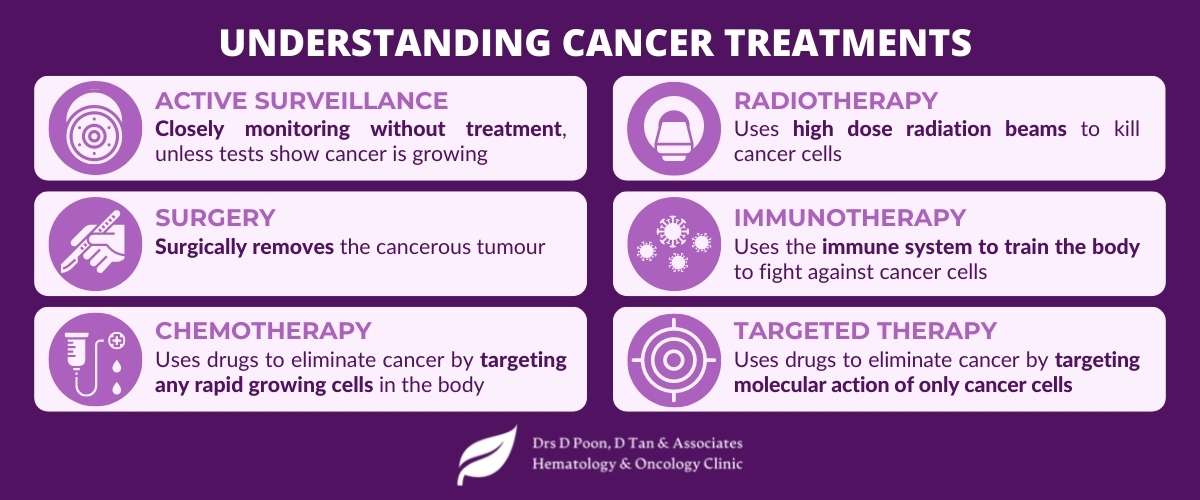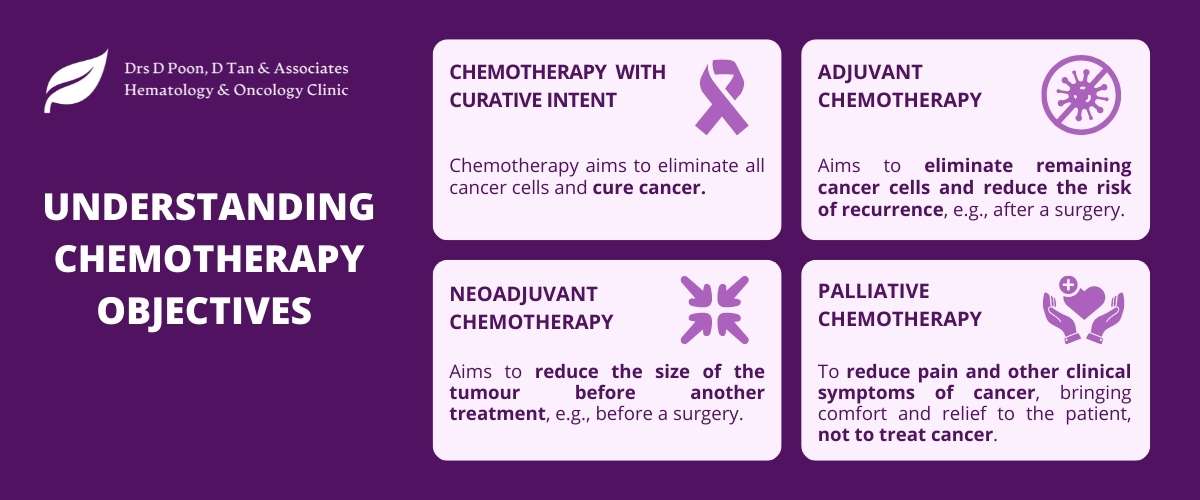
Common terminology in oncology: What does your cancer doctor actually mean?
As a doctor, I know we have a long-held reputation for the way we communicate. From doctor’s handwriting to doctor’s jargon, we have perhaps made our patients scratch their heads on several occasions. We have made them laugh about it too.
An example is my medical specialty. I would refer to myself as a medical oncologist, which differs from surgical oncologist and radiation oncologist. Medical oncologists treat cancer with medication (e.g., chemotherapy, immunotherapy) while surgical oncologists perform surgery and biopsy for cancer patients, and radiation oncologists provide radiation treatment. However, to most patients, I am simply called a cancer doctor or a cancer specialist!
In this article, I put together a list of common medical terms in oncology that you are most likely to come across as a patient or the patient’s family. Getting the hang of these terms will help you understand your condition better. The list is by no means exhaustive and you are recommended to clarify with your doctor anything you do not understand. Please note that the definitions below are simplified for oncology patient’s reference in Singapore context rather than for medical professionals’ usage in or outside of Singapore.
Lumps & Tumours
A patient often first comes into contact with cancer with the discovery of a lump. Being diagnosed with a lump may prompt you to think of cancer instantly. However, it is important to note that the majority of lumps are not cancers. In fact, only about 1 in 10 lumps found are cancerous.
Lumps can occur anywhere in the body, of any size and shape, and for various reasons. In oncology practice, a lump can also be referred to as a tumour, a cyst, a mass, lesion, or nodule. All these terms describe a group of abnormal cells in the body, with slight differences in meaning and usage.
- Lump: can be either solid or filled with fluid or air. A solid lump is often called a tumour while a soft lump is referred to as a cyst. Examples of cysts include epidermoid cyst, Ganglion cyst (Bible bump), ovarian cyst. Sometimes, you can feel the lump with your hand. Other times, it is inside the body and can only be seen with imaging tests.
- Tumour: generally refers to solid lump. However, you may hear your oncologist mention “liquid tumour”. In such cases, liquid tumours refer to cancers of the lymphatic system or blood, e.g., lymphoma, leukaemia and myeloma. This is to be differentiated with solid tumours which refer to cancer of the organs, e.g., breast cancer or liver cancer.
- Mass: medical term for a lump
- Lesion: originated from the Latin word “laesio” which means an injury or a wound, lesion describes a group of tissues that are damaged through a disease or an injury. In oncology practice, a lesion can be understood as a mass.
- Nodule: typically used to describe a tumour of 3 centimetres in diameter or smaller. Some oncologists use the term for tumours of 1 centimetre or less in diameter. Examples include lymph node nodules, thyroid nodules and lung nodules.
- Polyp: an abnormal growth formed in the lining of organs such as the colon, rectum, uterus, ear, and nose. There are different types of polyps. While most polyps are benign, certain types can become cancerous and require treatment. They may not have any symptoms and are only discovered during tests like colonoscopy (for colon polyp), or pelvic ultrasound (for uterine polyps or endometrial polyps).
- Adenoma: the term is a combination of two words of Latin roots – ‘adeno’ means related to the gland, and ‘oma’ means tumour. Adenoma refers to a benign tumour that develops from glandular cells. This type of cell is found in the lining of various internal organs such as the lung, stomach, colon, pancreas, breast, uterus, cervix, and prostate. They are responsible for producing and releasing enzymes, hormones and other substances. Though adenoma implies benign, some may potentially turn malignant and therefore require monitoring and treatment.
- Primary tumour & secondary tumour: The first tumour that develops in the body is referred to as the ‘primary tumour’. When cancer cells from the primary tumour travel to other parts of the body and form new tumours, doctors describe them as ‘secondary tumours’. This spreading process is known as ‘metastasis’. It is important to know the primary cancer because this will help guide treatment. For instance, a tumour may be discovered first in the liver. Further investigation finds that it first started in the lung. In this case, the primary cancer is lung cancer and the tumour in the liver is the secondary tumour.
Terms to describe a cancerous or non-cancerous tumour
To describe if a tumour is cancerous or non-cancerous, doctors often use the term benign, i.e., non-cancerous, or malignant, i.e., cancerous, or premalignant, i.e., pre-cancerous. During a consultation with the oncologist or when reading a medical report, you may come across terms such as a benign mass, a premalignant nodule, a malignant lesion, etc.
- Benign: A benign tumour does not spread to other parts of the body. If it is removed by a doctor, it generally does not return. There are different types of benign tumours, including adenomas, fibroids and hemangiomas. Examples include an adenoma polyp found during colonoscopy, a fibroid in the uterus, or a hemangioma of the skin.
- Premalignant: The tumour is not cancerous but may potentially become cancerous.
- Malignant: When a tumour is malignant, its cells can multiply rapidly and spread to other parts of the body in a process called metastasis. In oncology, malignant tumours include carcinoma, sarcoma and meningiomas.
Terms related to cancer types
When oncologists mention a cancer type, they always refer to the primary cancer. Some cancer types are easy to figure out, because they are made up of the organ names and the word ‘cancer’. Here are some examples:
- Breast cancer: cancer that originates from the cells in the breast
- Lung cancer: primary cancer that develops in the lungs
- Colorectal cancer: this is a combined term referring to cancer stemming from the colon or rectum. In some cases, the oncologist may describe it specifically as colon cancer or rectal cancer, which is cancer of the colon or rectum respectively.
- Liver cancer: cancer originating from the liver
- Prostate cancer: cancer that stems from cells in the prostate
- Hepatobiliary cancers: this might be difficult to understand if you are not aware of the term ‘hepatobiliary’. The hepatobiliary system consists of the liver, gallbladder and bile ducts. Hepatobiliary cancers are cancers originating from one of these organs.
- Stomach cancer: primary cancer of the stomach
- Skin cancer: cancer that first occurs in the skin cells
Some other cancer types may sound less familiar, because their names have origins in Latin words. You may come across terms such as carcinoma, sarcoma, lymphoma, melanoma or myeloma. The suffix ‘oma’ means ‘tumour’ in oncology. Below are what each of them means:
- Carcinoma: this is another umbrella term referring to cancer of the epithelial tissues that line the various organs in the body. Most cancers including lung cancer, liver cancer, colorectal cancer, breast cancer, prostate cancer, etc, are carcinoma. You may come across this term as part of medical names of cancers, or as part of the phrase ‘carcinoma in situ’. Being understood as ‘cancer in place’, carcinoma in situ refers to the earliest stage of cancer where cancer cells stay where they first form.
- Sarcoma: this umbrella term refers to over 50 types of cancer originating from connective tissues in the body, such as bone tissues, muscles, tendons, ligaments, or fat tissues. Itcan affect both older adults above the age of 60 as well as young children. (Read more about the various types of sarcoma, their signs, symptoms and treatment here)
- Lymphoma: this cancer develops in the lymphatic system which is a part of our immune system. There are 2 main types of Lymphoma, known as Hodgkin’s lymphoma and non-Hodgkin lymphoma. (More about them in the general cancer guide to lymphoma here)
- Melanoma: a type of skin cancer that develops from the melanin-making cells called melanocytes. It is rare but can be fatal if diagnosed at a late stage. (Learn about melanoma and why its late detection rate in Singapore is high here)
- Myeloma: since ‘myel’ is the medical term for ‘bone marrow’, myeloma refers to cancer of the bone marrow. In myeloma, the plasma cells that are found in the bone marrow grow out of order. The condition is also called multiple myeloma, because people with this condition typically have many abnormal plasma cells in the bone marrow.
Above are the common broad types of cancer, which in turn have subtypes. The subtypes almost always have medical names, often denoting the types of cells that cancers start from. Let’s take liver cancer as an example. There are 4 common liver cancer subtypes:
- Hepatocellular carcinoma: it develops from a type of liver cells called hepatocytes
- Cholangiocarcinoma: ‘cholangio’ refers to the bile duct and the term refers to liver cancer starts from the part of the bile duct located in the liver
- Liver angiosarcoma: this subtype of live cancer begins in the blood vessels in the liver (‘angio’ means blood vessel in medicines)
- Hepatoblasma: ‘blastoma’ indicates immature cells while ‘hepato’ indicates the liver. The combined term refers to a type of liver cancer occurring mostly in young children.
It is impossible to list all subtypes of cancer here. The purpose of explaining the cancer types and subtypes is to illustrate the meaning behind the names. Understanding this logic, you can have a good grasp of other medical terms too.
Common terms used during cancer diagnosis
To confirm if a tumour or mass is cancerous, and if so, what is the nature of the cancer, a series of diagnostic steps will be carried out. During the diagnosis process, you may encounter terms such as tumour marker in your blood test or urine test result, or asked to go for molecular testing or biopsy. Below are what they mean.
Tumour marker and molecular marker
Tumour marker and molecular marker are 2 types of biomarkers most commonly encountered in oncology. They indicate the presence of substances that are associated with certain cancers or benign tumours. Oncologists use these biomarkers, together with other evidences, to confirm a diagnosis, monitor treatment outcome or predict the behaviour of cancer during and after treatment.
Tumour marker:
They are substances that are produced by the cancer cells in response to the presence of a tumour. They are measured through blood tests, urine tests or biopsies. Not all cancers have a known tumour marker, and one tumour marker may be associated with several types of cancer. For instance, PAP (Prostatic Acid Phosphatase) is linked to metastatic prostate cancer, lung cancer and myeloma.
Note that tumour markers are “not specific” for cancer, which is to say that other medical conditions may also cause tumour markers to rise. So if you go for a health screening and receive blood tests indicating abnormal levels of certain tumour markers for the first time, do not panic yet. This needs to be investigated but the markers alone do not confirm you have cancer.
On the other hand, some patients do not show elevated levels of tumour markers despite being diagnosed with cancer. This is the case with AFP (Alpha Fetoprotein) tumour marker which is associated with liver cancer. Some liver cancer patients have normal AFP levels until late stage. AFP tumour marker is also an example of the non-specific nature of tumour marker. A number of people with high AFP levels have other liver conditions or other cancers and not liver cancer (More about AFP and liver cancer here)
Molecular marker (DNA marker):
Containing DNA fragments, molecular markers can reveal the changes in gene sequences (known as mutations), gene expressions, and other indicators of the characteristics of cancer cells. In oncology practice, it helps doctors understand how cancer is likely to behave and determine suitable treatment plans for the patient.
Molecular markers are reported after molecular tests. Such tests analyse a sample of tissue, blood, or a body fluid to look for the presence of target gene, protein or other pieces of molecular information. A type of molecular tests we have all become familiar with is PCR test. In oncology, molecular tests can be used for diagnostic or screening purposes. You may hear other names such as molecular profiling or genomic profiling. Find out more about specific tests available in Singapore for cancer screening purposes, and tests for cancer diagnosis here.
Biopsy
Biopsy is a procedure oncologists commonly order as part of the cancer diagnosis process.
A surgeon uses a needle to take a small amount of tissue from the area where the cancer cells may be present. It is considered the gold standard in oncology diagnostics, as it offers a reliable method to diagnose a tumour by examining closely the tissues involved.
Depending on the location of the tumour and the sample required, surgeons may perform:
- A needle biopsy: to collect a small tissue sample using a needle.
- A surgical biopsy: to collect a sample during a surgery which often also removes the entire tumour.
The above methods are called tissue biopsy.
Liquid biopsy is a relatively new type of biopsy, which excites me and many fellow oncology practitioners. Liquid biopsy looks for genetic materials of cancer from a blood sample. It is quick, easy to perform, almost painless to the patient and does not have the side effects that tissue biopsy may have. An example is the Lucence liquid biopsy test. It is used to support diagnosis, treatment selection and monitoring for a number of lung, breast, colon and blood cancer types.
Imaging tests
Imaging tests help doctors look inside of the body. They are a pivotal diagnostic tool. They can also be used during treatment to monitor progress, and after treatment for surveillance purposes.
X-ray, PET, CT and MRI scans are the most common imaging tests a cancer patient encounters. You may wonder why the doctor orders one type of imaging scan and not another. Below is a brief rundown:
- X-ray: quick and inexpensive, it is most commonly used to check for tumour in the lung or bone.
- CT (computerised tomography): this scan shows a 3D view of the internal organs inside the body. CT scan is very useful for a wide range of tumours, except for specific circumstances where PET or MRI scan show better results, as discussed below.
- PET scan (positron emission tomography scan). It can be done together with a CT scan but sometimes, the PET-CT scan is called just PET scan for short. A PET scan is able to show the functions of organs inside the body by indicating the increase in their ‘activities’. Doctors typically use PET scans to check if cancer has spread and to stage cancer during diagnosis. It can also be used to check for new cancer growth after treatment. The way PET scan works means that you should refrain from physical exercises and remain quiet before the scan for the most accurate result.
- MRI (magnetic resonance imaging): MRI is known to provide superior imaging quality for soft tissue tumours such as sarcoma. As such, doctors use MRIs to diagnose and monitor sarcoma, prostate cancer, uterine cancer, sometimes liver cancers, and tumours in the bone and brain.
Terms related to staging of cancer
Most patients want to know the stage of their cancer. Most cancers are staged from 1 to 4, and the severity increases as the number goes up. Some cancers also have a stage 0, also referred to as ‘carcinoma in situ’.
The same stage for different cancers has diverse meanings in terms of treatment and prognosis. You should always discuss with your oncologist to find out what the stage in your individual case means.
In addition to Stage 1,2,3,4, you may encounter other terms related to cancer staging.
- In situ: This Latin word means “in place”, indicating that the cancer is still at the place where it started. It has not spread to the surrounding tissues. Surgery is commonly performed to remove the entire tumour. For instance, a breast cancer case is described as “ductal carcinoma in situ”. This is to say that cancerous cells are detected inside the milk duct in the breast and they have not spread to other tissues outside the milk duct.
- Non-infiltrating / Infiltrating : When a cancer is described as non-infiltrating, it stays at the tissue layer where it initially developed from and has not spread to the surrounding tissue layers. On the contrary, infiltrating cancer has spread to surrounding tissues.
- Non-invasive / Invasive: Used interchangeable with non-infiltrating / infiltrating. When a cancer is non-invasive, it is found in the earliest stages, i.e., stage 0 or 1.
- Metastasis: Metastasis occurs as a result of infiltrating or invasive cancer. In metastasising cancer cases, cancer cells have found their way to other organs or body parts through the bloodstream or lymph system. The new growth is referred to as a metastatic tumour.
Common terms used during cancer treatment
Cancer is generally treated using of one or a combination of the following treatments:
- Surgery: removing the tumour by surgical means.
- Chemotherapy: destroying cancer cells by the use of chemical substances. The drugs are delivered to the body orally, i.e., taken as pills, or intravenously, i.e., through vein injection. You may hear oncologists refer to these drugs as chemotherapeutic agents. Nowadays, advances in chemotherapy techniques such as Hyperthermic Intraperitoneal Chemotherapy (HIPEC) have helped to reduce side effects for patients.
- Radiotherapy: eliminating cancer cells using high energy beams. Advances in radiation oncology have resulted in improved precision in targeting with less damage to healthy tissues. These advanced techniques include Trans-arterial Radioembolisation (TARE), Stereotactic body radiation therapy (SBRT), Leutetium-DOTATATE. Learn more about these cancer treatment therapies here.
- Immunotherapy: this therapy harnesses one’s own immune system to fight against cancer. It is a type of biotherapy. If you would like to learn more about immunotherapy, check out my article titled “A primer on immunotherapy for everyone”.
- Targeted therapy: destroying or controlling cancer cells by the use of drugs targeting specific protein that helps the growth and spread of the tumours.
In certain cases of early-stage and low-risk cancer, the oncologist may recommend Active Surveillance. Cancer is monitor closely without treatment, unless regular exam or test results show cancer is growing and requires intervention. Examples of this approach can be seen with low-risk prostate cancer or urethral cancer.

A therapy may be used to achieve different objectives during the treatment journey. Taking chemotherapy as an example, depending on treatment goal, you may hear your oncologist mention:
- Chemotherapy with curative intent: this is when chemotherapy is used to cure cancer.
- Neoadjuvant chemotherapy: often done before a surgery to reduce the size of the tumour and reduce the risk of spreading.
- Adjuvant chemotherapy: used after a surgery, its goal is to eliminate remaining cancer cells, reducing the risk of recurrence or metastasis.
- Palliative chemotherapy: It is aimed not to treat cancer but to reduce pain and other clinical symptoms of cancer, bringing comfort and relief to the patient. Palliative treatment is to be differentiated with curative treatment which aims at curing, treating and promoting recovery from cancer. For instance, when the tumour presses on a nerve, causing the patient intense pain. The oncologist may recommend palliative chemotherapy to shrink the tumour and relieve the pain.

Common terms used after cancer treatment
These are some common terms you may come across after treatment is successful:
- Remission: Implies that the symptoms of your cancer are reduced. Remissions may be partial or complete. A complete remission means that no signs and symptoms of cancer are detected. A partial remission means that cancer is still present but the size of the tumour has greatly reduced.
- No evidence of disease (NEOD or NED): This term refers to the same as complete remission. Achieving NED does mean that the treatments were effective in eradicating the cancer cells. It does not mean that the cancer is completely cured since there is a chance that the cancer may return in the future.
- Cancer free: Since there is a risk cancer can return after remission, the term ‘cancer free’ is often used after a sufficiently long period of surveillance. It implies that there is no chance of the cancer ever recurring. The once cancer patient is now a cancer survivor.
- Relapse: Also known as cancer recurrence, the term refers to the return of the cancer after it was successfully treated and controlled. Most cancers that recur do so within the first two years after treatment.
- Post-treatment surveillance: The objective of surveillance is to monitor and detect if and when cancer returns. It involves frequent follow up visits to the oncologist and checkups. Most cancers that recur do so within the first two years after treatment.
Takeaway Message
I hope the above article clarifies common oncology terms in easy to understand language for the benefit of cancer patients, their families and interested public audience. My general advice is to ask for an explanation from your oncologist any time you receive information regarding your diagnosis or treatment that you do not fully comprehend. As doctors, we do not confuse our patients on purpose. We also do not use handwriting much nowadays. It is my hope that our reputation in communication has been and will be further improved.
Dr Donald Poon




